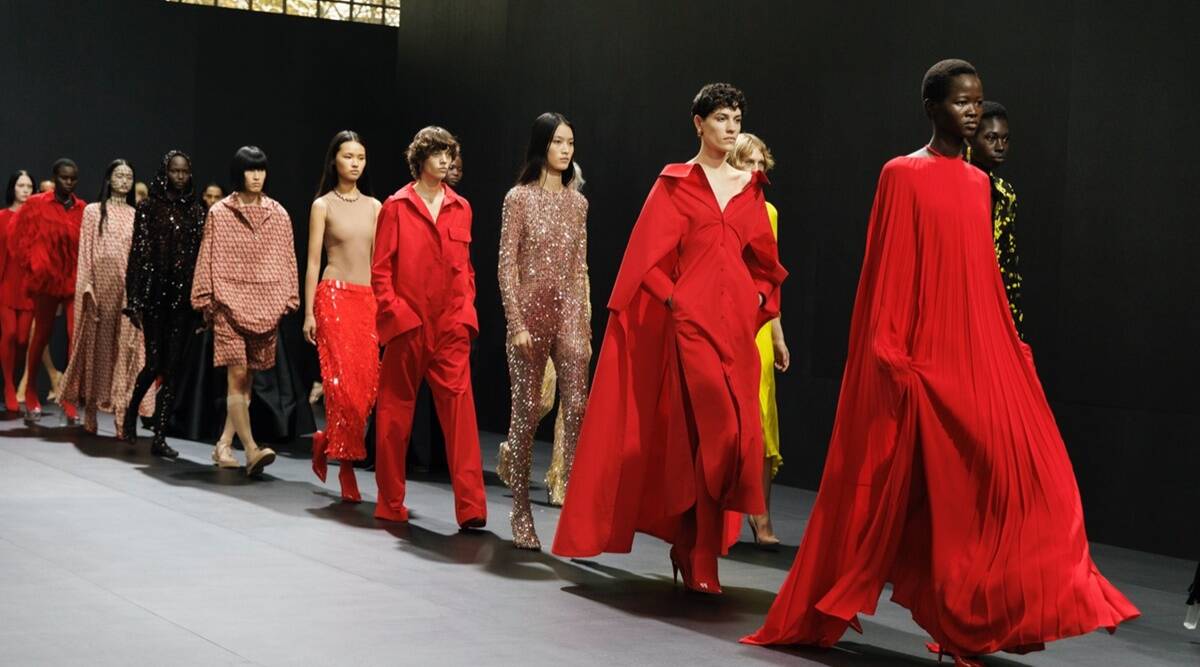PARIS — We live in a dirty, dirty world.
A world where muckraking, mudslinging and drain-the-swamp chanting are just part of daily life. Little wonder Demna, the mononymous designer of Balenciaga and master of the visual metaphor, decided to get down into the pit and wallow.
To be specific: He decided to truck in 275 cubic meters (more than 9,700 cubic feet) of black mud harvested from a French peat bog and dump it in the middle of a convention center on the outskirts of Paris. It was smooshed onto the walls, sliding down the sides of an enormous trough, and dug into a shallow catwalk along the edge, seeping with water, all courtesy of the Spanish artist Santiago Sierra. The air was pungent with a moist eau de peat (a special scent had been created to enhance the smell of decomposition), and slime was oozing across the aisles. Guests picked their way carefully to their seats, terrified of wiping out.
Buy Now | Our best subscription plan now has a special price
The set was, Demna wrote in his show notes, about “digging for the truth and being down to earth.” If that requires getting your hands (and feet and clothes) gunked-up, so be it. While his couture has become his experiment with Balenciaga’s legacy, the ready-to-wear has become his means of social commentary. It isn’t pretty out there. His mud club wasn’t either.
Ye (the artist formerly known as Kanye West, and a longtime Demna co-conspirator), stomped out, in leather biker pants, an oversize flak jacket, baseball cap and Balenciaga-logo mouth guard, made up to look as though he had been punched in the face. Well, you have to fight for what you believe.
Then came a host of stragglers — strugglers? — men and women, in baggy jeans shredded from the back and dropped low on the hips to show the Balenciaga-logo waistbands of their underwear. There were Hulk-size nylon jackets and dirtied-up sweatshirts with matching running shorts and handbags made from old teddy bears that looked as if they had been disinterred.
A model presents a look at the Valentino spring 2023 fashion show (Valerio Mezzanotti/The New York Times)
Some guys wore ballet flats on their feet and baby carriers on their front, with eerily lifelike baby dolls inside (giving new meaning to Dad jeans). Scarves corkscrewed down the body, jouncing up and down. One shoulder bag had an integral sleeve, so it could be worn like a gauntlet. The hem of a lipstick-red, pleated silk gown turned brown in the dirt; ditto a pink jersey number knotted multiple times on the side; also a crystal-sprinkled mesh tank gown. The last look was a leather dress pieced together from a host of cut-up Balenciaga handbags.
There was no hierarchy of preciousness here, which is part of the point. One Demna has been making since he first put Balenciaga crocs on his runway years ago, and that he has been exploring ever since with leather garbage bags and desiccated sneakers, among other accessories. It’s button-pushing of the most calculated kind. People freak out, but he sets an agenda.
What makes a garment qualify as “luxury?” Is it the material, the decoration, the impracticality? Backstage, afterward, surrounded by a crush of reporters waving smartphones in his face, Demna talked about the work that goes into making a new garment look permanently destroyed (it’s technically hard). So would you feel like an idiot paying an exorbitant price for a purposefully muddied sweatshirt? Maybe — but there’s precedent with ripped jeans.
And really, who’s the emperor with new clothes in this scenario: the person who blindly accepts the values handed down to them by others, or the one who buys into the idea of turning those values inside-out?
They don’t call it filthy lucre for nothing.
Ye — who was in Paris because he was scheduled to hold his own surprise Yeezy show Monday night — seemed on board with the idea, later making a front row appearance at Matthew M. Williams’ Givenchy show, still wearing his mouth guard and makeup bruise.
Held outside, in the Jardin des Plantes, in the rain, it was Williams’ first pure womenswear show for Givenchy after two years of combining both genders on a single runway, the better to clarify his vision for the brand.
Piccioli designed his entire collection on a series of stretch body suits in five different skin tones (Valerio Mezzanotti/The New York Times)
Which was … a clash! Of cultures and style stereotypes, Paris and L.A., as told through destroyed jeans, baggy cargo shorts, cropped ruffled blouses and tweed bouclé. Knock me over with a trench coat.
While more coherent than his previous outings, however, it wasn’t any more original. This particular version of street-meets-chic is now so familiar, see Hedi Slimane’s Celine, that it looks like part of the fashion furniture. And a finale of LBDs (long black dresses) was elegant, but blandly archival. Williams’ Givenchy is not bad. It’s just unmemorable. It doesn’t make you feel much of anything.
Unlike say, Pierpaolo Piccioli’s Valentino, which is pretty much overflowing with emotion. In a preview, Piccioli talked about his frustrations with fashion’s lip service to inclusivity, even as prices go through the roof, and with its continued allegiance to a very specific body type.
(As far as the latter, he’s right, with one glaring exception: Ester Manas, by far the most inclusive brand of the season, which shows not just skinny models and a handful of curvy ones, but every single permutation in between — and then puts them in body-friendly lingerie and ruched styles that seem like a genuine pleasure to wear.)
To change that, Piccioli eschewed the particular shade of hot pink that had defined his last collection (and was displayed in hi-def on many in his audience this time around), building his entire collection instead on a series of stretch body suits in five different skin tones. They were the underpinnings and backdrop for a panoply of caped dresses, elastic-waist full skirts and slouchy trousers. Most looks were composed from a single piece of fabric, so that even when the surface was highly decorated (with sequins, say, or pleats), the structure itself was exquisitely simple.
The idea being that, instead of transforming the body to fit the garment, the garment ought to transform to fit the body; that the person dictates the dress. A point that, like Demna’s mud club, is another challenge to the status quo worth celebrating. Even if it was undermined, somewhat, by head-to-toe Valentino-logo outfits (where the logo was also painted onto the model’s face) and shoes so unwalkable that numerous models had to take them off.
Still, the fact that the women felt empowered to do so is perhaps a step forward in itself. Afterward, they all went out into the damp street, so the gathered hordes of fans could see what had been going on. The looks got a little grimy, but no one blinked an eye.
This article originally appeared in The New York Times.
📣 For more lifestyle news, follow us on Instagram | Twitter | Facebook and don’t miss out on the latest updates!






